What is HR analytics?
When HR professionals need to collect data that informs human resource management, employee productivity and business performance, look no further than HR analytics.
As mentioned above, HR analytics are tech processes for:
- collecting raw data relating to your employees
- analyzing that data
- providing insights you can use to make well-informed business decisions
They are not the same as people analytics and workforce analytics — there are subtleties between them. For example:
HR analytics includes HR function metrics for each employee such as time to hire and lifetime training expenditure.
People analytics includes all people associated with the company, including customers.
Workforce analytics includes all people who do work for the company — not only employees, but also contractors, consultants, freelancers, gig economy workers, and remote workers.
The nuances between the tools are crucial because they’re used for and in different circumstances, providing critical insights depending on what you need.
Free eBook: 2025 employee experience trends report
What is predictive HR analytics?
HR professionals use predictive analytics – a digital tool – to analyze available past and present data to predict possible future outcomes.
Predictive analytics crunches data to extract, examine and segment information. It can then identify patterns, anomalies and relationships within that data.
The resulting statistical analysis and predictive models that can be drawn from HR metrics then help HR leaders make clear, data-backed decisions.
Predictive human resource analytics can:
- Mitigate risk
- Inform successful recruitment practices
- Forecast what types of employees will do best in the organization
- Spot who is likely to leave the company
- Estimate salary level for new job functions
- Reduce human errors
- Improve company culture
- Increase employee engagement, retention, motivation and productivity
- Make the business more profitable
What is HR analytics used for?
You can use HR analytics to solve all manner of business problems, develop business strategies and understand the attitudes and perceptions that contribute to the whole workforce’s employee experience. HR analytics can:
- Measure a range of crucial areas such as wellbeing, performance, and DEI
- Provide concrete evidence that leaders can use to improve organizational and employee performance
- Demonstrate the true impact of new processes and policies on employees and the organization
- Reveal the return on investment (ROI), both financial and human, of new initiatives
- Help enhance employee engagement by measuring what drives it, and what needs to be done to keep employees happy
- Help retain your valuable employees, by identifying what’s making people leave, and highlighting problem areas to address to prevent high employee turnover
What is the business impact of HR analytics?
Without the right tools to highlight what’s going on in a company, a business’s financial performance can suffer through people-related issues, such as:
Turnover
Employee turnover is incredibly expensive. It’s estimated that it costs between 50% and 200% of an individual employee’s annual salary to replace them. And when you realize that in 2020, the average US company’s annual turnover rate was 57.3% — that’s a phenomenal amount of money.
HR analytics can help you identify why people are leaving so you and your HR department can put initiatives in place to retain them, and track the success of those initiatives too.
Employee engagement
Companies with highly engaged employees:
- Are 17% more productive
- Score 10% better on customer ratings
- Make 20% more sales
- Demonstrate 41% less absenteeism
- Have 59% less turnover
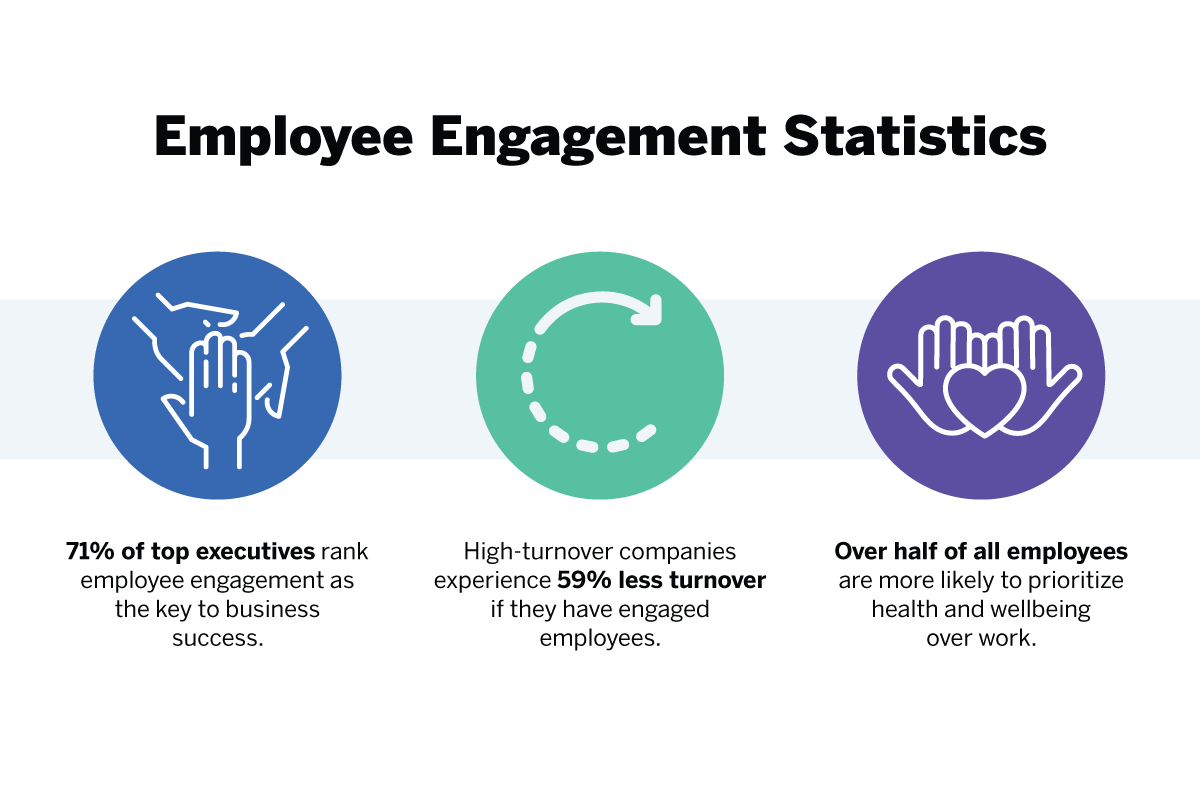
HR analytics will help you increase employee engagement by highlighting areas and pain points where your employees are not happy, so you can focus on improving those. And you’ll easily be able to track those initiatives to measure their success and even predict future engagement issues.
Goal setting
HR analytics are useful for achieving set goals that save the company money. You can select a specific business area that you want to improve and apply suitable metrics and assessments, gather the data you need, analyze the results, then act on the findings.
Develop top talent from within
You want to keep your best people and develop them so that they become your future leaders, not your competitors’. With the right performance reviews (such as 360 assessments) feeding into your HR analytics, you can understand your employees’ experience, act on any engagement issues, slot in the right training, and develop their careers – all so they stay with you.
Banish bias (and its legal consequences)
Title VII of the Civil Rights Act of 1964 prohibits employment discrimination based on race, color, religion, sex (including gender, pregnancy, sexual orientation, and gender identity) and national origin. Employees who perceive bias and unfair treatment will, at best, leave your company, at worst, take you to court. HR analytics can help your company fight bias by informing DEI initiatives and standardized, benchmarked processes and professional assessments that treat all candidates and employees fairly.
Teams that belong
According to a study by Deloitte, when companies build strong teams of happy, collaborative, and diverse people who feel they belong, they can look forward to:
- 56% increase in job performance
- 50% reduction in turnover risk
- 167% increase in employer net promoter score
- 75% decrease in sick days
HR analytics enables HR professionals to build these enviably engaged teams. It can inform the recruitment process to ensure the right people are hired, analyze performance reviews so the right people get promoted, and investigate pain points and employee experience issues for prompt resolution.
How does HR analytics work?
These tools are dependent upon sophisticated technology developed by data scientists. The best systems use machine learning, artificial intelligence (AI), and natural language processing (NLP) to uncover insights, predict behaviors, personalize every employee’s experience, and save time by automating repetitive tasks and alerts for actions.
For example, NLP can read text feedback and understand its meaning and nuances, which it can then turn into qualitative, and even quantitative data.
Also, HR analytics works across the entire employee lifecycle, so you can see what’s driving engagement at every significant point:
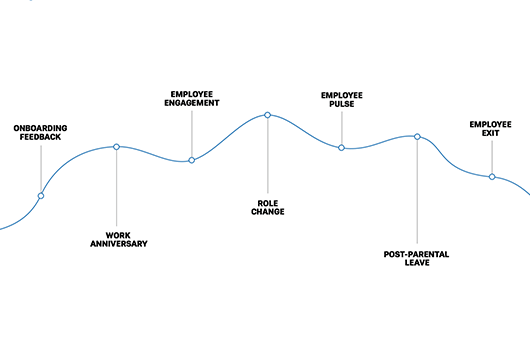
The best tools will combine HR data (e.g. employee demographics, salary, training records) with experience (X) data (from surveys and feedback) with operational (O) external data (e.g. revenue, costs, customer experience, health and safety) to give a holistic picture built from factors that influence each other.
What data does an HR analytics tool need?
Gathering quality data of the right type is a major challenge for HR teams. The data that HR analytics tools need is classified into two categories:
1. Internal data
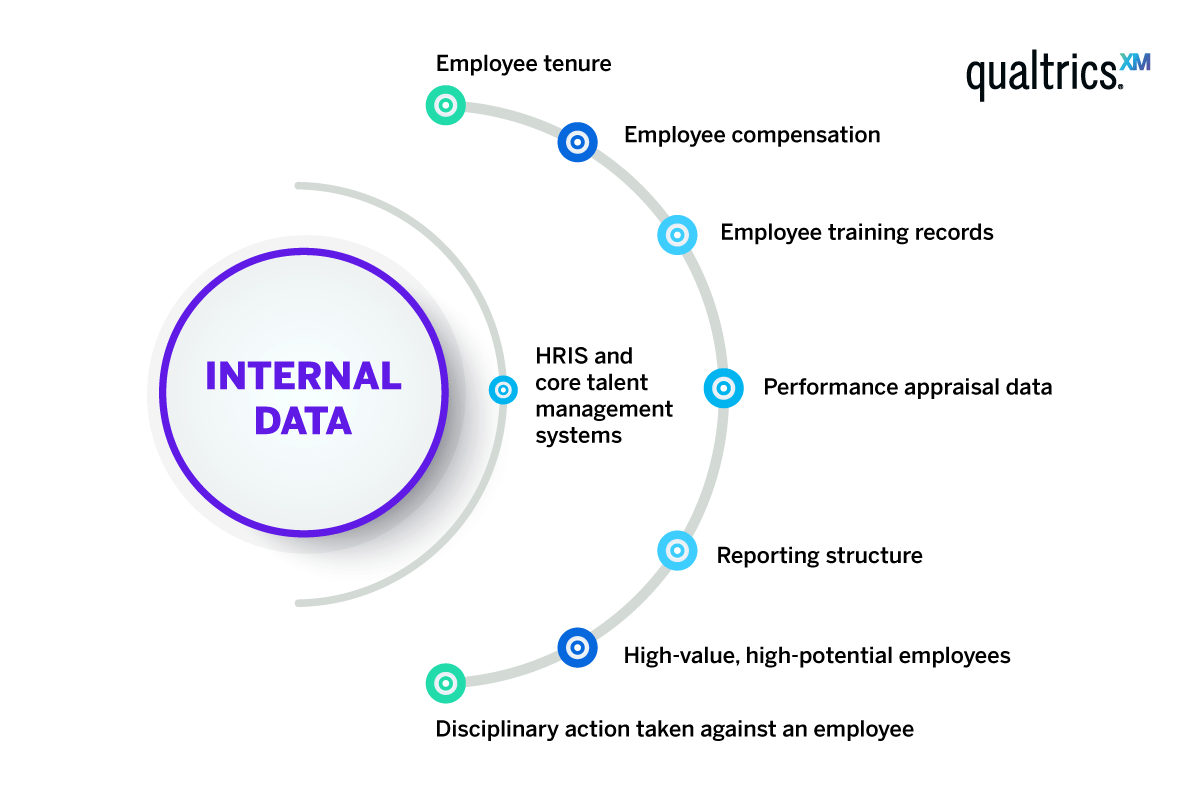
Internal data is that held by an organization’s human resources department on its HRIS (human resources information system) and core talent analytics systems. The HRIS contains relevant data that can be fed into an HR analytics tool.
Key internal HR metrics on the HRIS include:
- How long an employee has worked for the organization (employee tenure)
- Money and benefits paid to an employee (employee compensation)
- Employees’ training records
- Performance management and appraisals data
- Reporting structure (the chain of command – who reports to who)
- High value employees
- High potential employees
- Disciplinary action records
Sometimes this data can appear somewhat siloed and scattered and requires organization before it can be fed into HR analytics software.
2. External data
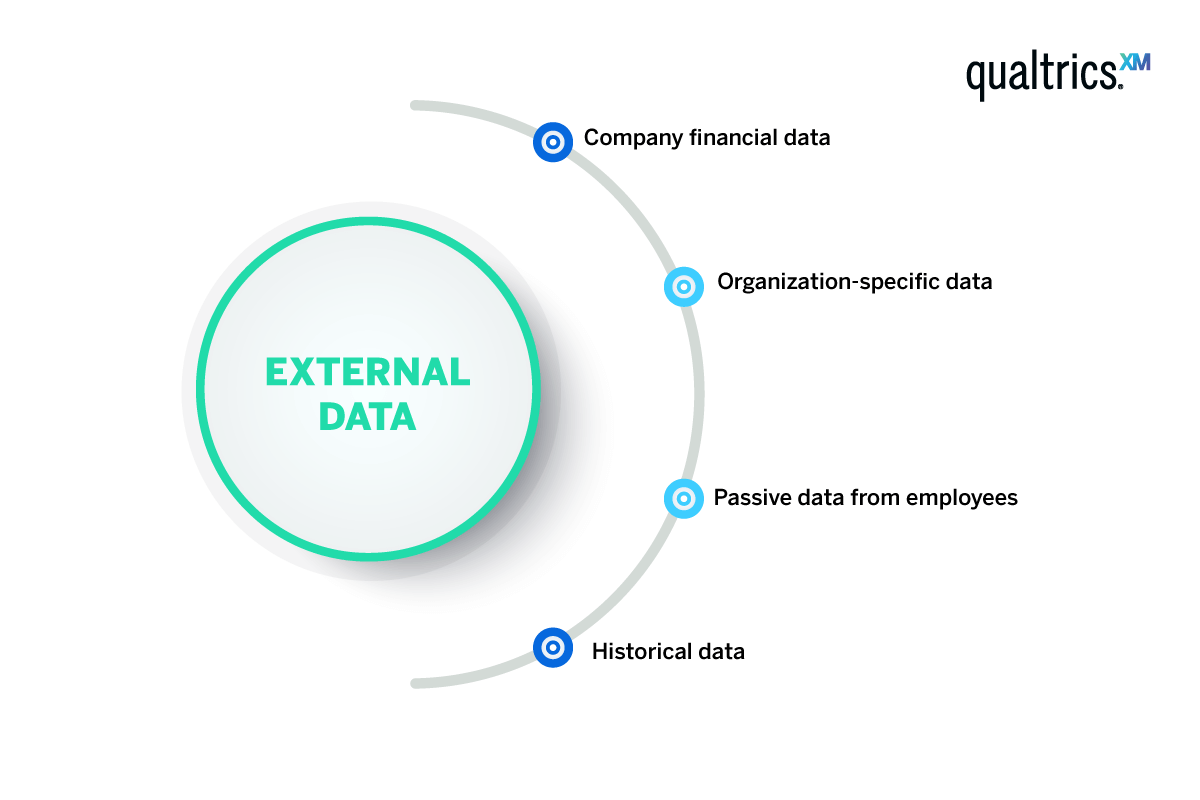
External data gets fed into the HR department from other departments within the organization, and even from outside it. It’s also known as O-data (operational data).
Key external data sources include:
- Financial data: the driving force of any business, and one of the key metrics to calculate the costs of employees (cost per hire, revenue per employee, turnover)
- Organization-specific data: a hospital will have different types of data (patient outcomes, staffing, equipment, legal) from a retail store (branch revenue, overhead costs, customer experience), which will have different data from an engineering company (materials, health and safety, regulatory). Different types of data will need to be processed by the HR department for each specific industry
- Passive employee data: the everyday interactions that employees have with their companies, including feedback surveys, social media posts and likes and shares that involve the company
- Historical data: Employee behavior is influenced by geopolitical, economic or environmental global happenings, including ‘black swan’ events such as 9/11, Brexit, the 2008 Global Financial Crisis and the Covid-19 pandemic.
10 common HR analytics metrics
- Time to fill: The length of time between a job advert appearing and a candidate accepting a job offer. The more streamlined your recruitment process, the better the candidate experience.
- Time to hire: The length of time between a candidate’s first approach and accepting the job offer. This also reflects the quality of candidate experience.
- Offer acceptance rate: How many formal job offers are accepted out of the total number given.
- Training efficiency: By analyzing several data points including performance improvement, extra responsibility, and promotion, HR professionals can assess how good your training is, and whether to increase training expenses.
- Employee engagement: Surveys, performance reviews, and productivity measurements combine to measure how happy, satisfied, and engaged your employees are.
- Revenue per employee: the average revenue each employee brings in.
- Turnover rate (voluntary): When employees choose to leave (attrition). This metric is crucial for understanding what went wrong in the employee’s experience to make them quit.
- Turnover rate (involuntary): When employees are sacked or made redundant by the company. This metric can highlight problems with the recruitment process not selecting the right people.
- Absenteeism: A particularly telling HR metric. Low absenteeism indicates a healthy workforce with good employee engagement.
- Human capital risk: The gap between a company’s goals, and the skills and experience of its workforce needed to attain them.
How to get started with HR analytics to increase business outcomes
Increasingly, businesses are moving away from gut instinct strategies to more big data-driven decision-making. HR analytics are ideal for this. Here’s how to get started.
1. Identify a problem to be solved
You might be worried that too many people are quitting, or you’re spending too much on recruitment. You might want to identify high-performing employees for promotion. You can do all of this by linking HR analytics to clearly defined business outcomes. Keep it simple with high-impact, low-effort endeavors.
2. Define what success will look like
A reduction in employee turnover, less money spent on recruitment and several high flyers on advanced management training courses will signal that your strategy using HR analytics has worked.
3. Audit your existing data
You may well have some useful HR data as a starting point. But not all, and gaps will begin to emerge. To help this process, centralize all employee data that you may have spread across several systems of varying quality into one repository.
4. Design the process
Who will run the project? Your HR department? What resources do they need? What do stakeholders need to know? What is the timeframe?
5. Design the strategy for data collection
Are you going to run surveys? If so, what type – engagement surveys, pulse surveys, 360 surveys, one on one meetings? Work out who you are going to target and how you are going to process the data once it comes in.
6. Collect the data
This may come from existing records, or you may wish to gather new data through surveys and feedback. The big advantage of having an HR analytics system in place that crunches all your employee data is that it’s always on, interacting holistically with other metrics and showing patterns and gaps.
7. Analyze the data
Analytical methods take the raw HR data, identify trends and patterns within and deliver it in a readily understandable form. There are three types of data analytics:
- Descriptive HR analytics is a snapshot that describes the status quo using historical data and identifies areas of improvement. It can be combined with multidimensional data to investigate a specific problem
- Predictive HR analytics uses existing data in statistical models to forecast future trends, opportunities and risks
- Prescriptive HR analytics combines descriptive and predictive analytics to recommend solutions automatically
8. Report the findings from the data
Nobody wants to sit in front of a Powerpoint presentation of numbers. Instead, turn your data analytics into visuals and tell a story with it – your HR data collected is so much more powerful when you deliver it as a visual narrative.
9. Keep refining your HR analytics
Once you’ve started using HR analytics to solve your business issues, keep tweaking it and feeding it to make it even more intelligent. Be mindful of transparency, keep employees informed, and guard against any bias that may discriminate against minority groups in your organization.
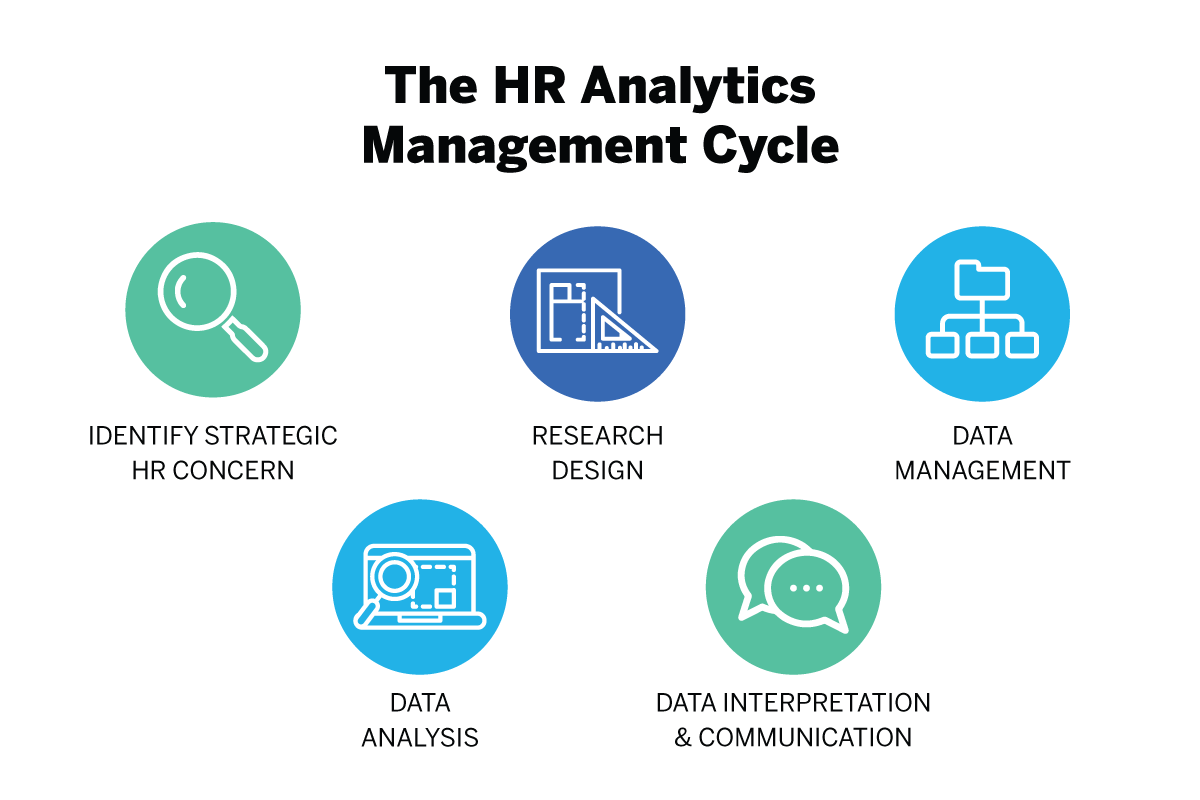
Should I invest in HR analytics software?
HR analytics Frequently Asked Questions (FAQs)
1. What is HR analytics?
HR analytics help you manage people at work using a data driven approach. They are tech processes for collecting the raw data that relates to your employees, and then analyzing that data. It then provides insights you can use to make better, well-informed business decisions.
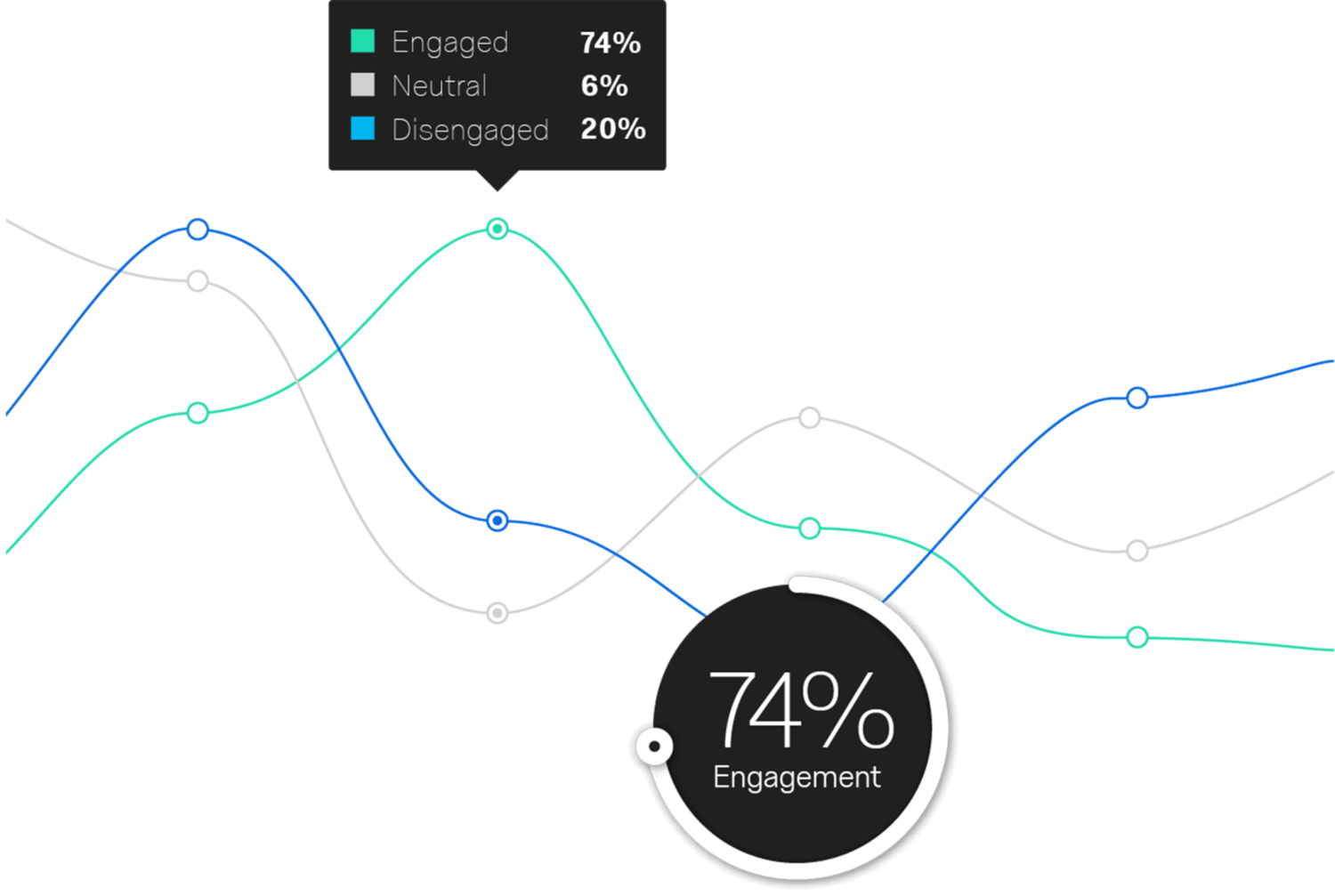
2. What are the most common data sources for HR analytics?
You should use both internal and external data sources:
Internal data could include employee engagement, demographics, recruitment, payroll, performance management, training, compensation and benefits, succession planning, employee survey data, customer relationship management, financial, production management, sales, and social networks.
External data could be population, labor market stats, social media data.
3. Are people analytics and workforce analytics the same as HR analytics?
No – we think there are differences:
HR analytics measure HR function metrics for each employee, such as time to hire and lifetime training expenditure.
People analytics includes all people associated with the company, including customers.
Workforce analytics includes all people who do work for the company — not only employees, but also contractors, consultants, freelancers, gig economy workers, and remote workers.
4. What expertise do you need for making HR analytics a success?
You’ll need:
- consultants to pinpoint areas that need improvement and develop strategies
- HR initiatives for gathering data
- data scientists and data analysts to run the analytical process
- management to bring key stakeholders on board
- an HR professional with a gift for storytelling to turn data driven insights into a narrative that everyone can understand
5. Should I invest in HR analytics software?
HR analytics help you automate and streamline processes to reduce costs and employee turnover while improving employee engagement and bringing in more profit.
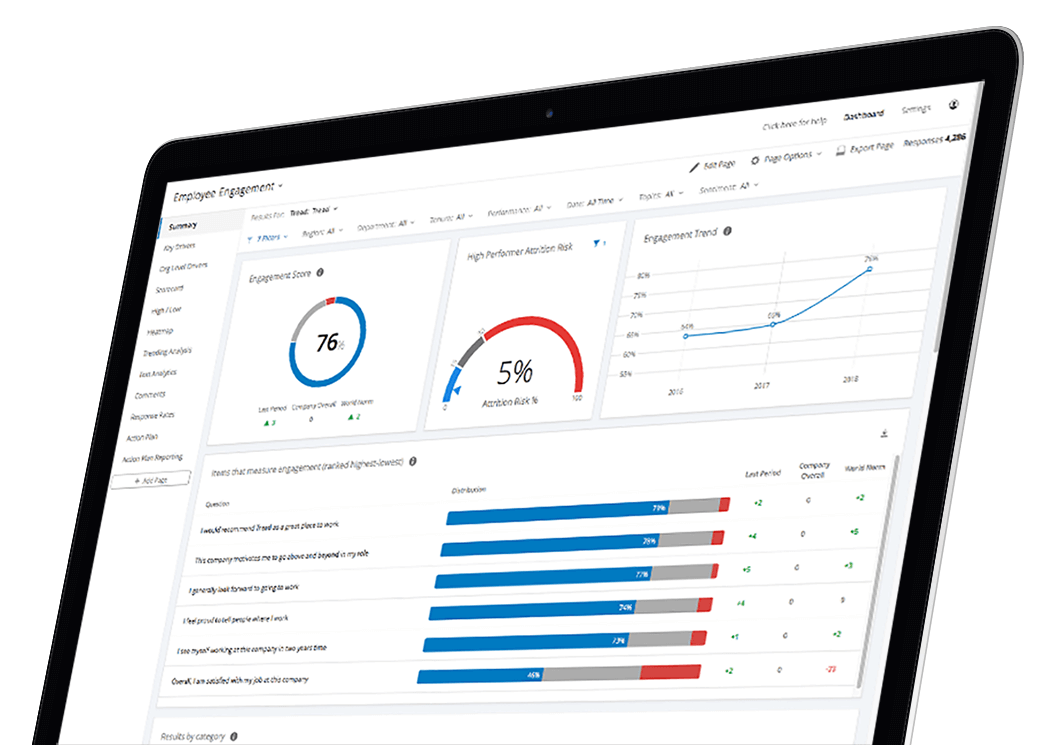
Your HR professionals can concentrate more on the humans in human resources, rather than endlessly crunching numbers from disparate silos, as long as you use your analytics holistically. By investing in good HR and people analytics software, you’ll be able to:
- Turn billions of employee data points into actions
- Analyze engagement at every stage of the employee lifecycle
- Remove the guesswork from hiring, engaging, developing, and retaining the best people
- Know what employee benefits matter most to your people.
Free eBook: 2024 employee experience trends report